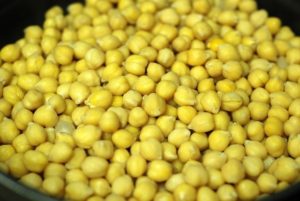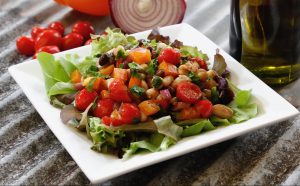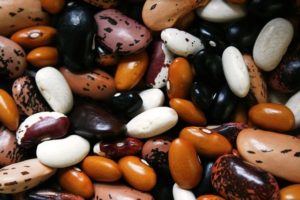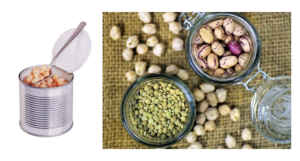 “Beans, beans, the magical fruit”…
“Beans, beans, the magical fruit”…
we all know the rest of this, right?!
Why beans?
Beans are a nutritional powerhouse, but are sometimes under appreciated. Beans of all kinds provide an excellent and super-easy way to get more protein and fiber into your routine!
Actually, consuming these bundles of protein, potassium and soluble fiber at least 4 times per week has been found to reduce heart disease by 21%! And, if you are like us, your go-to is likely canned beans (hopefully of various varieties) because they are so quick and easy!
Honestly, we don’t cook dried beans as often as we should because it requires more time and planning than just opening up a can…the soaking, the cooking…and some dried beans can take up to 2 hours to cook! Are you thinking “who has time for that?!” But we do love the idea of cooking a big batch of beans and having them on hand for quick meals throughout the week.
Here are a few tips about beans, things to keep in mind, and how to make magic happen in the slow cooker!
Dried beans vs. canned?
 Loaded with nutrition! Both dried and canned beans have similar nutritional benefits when it comes to calories, fiber, protein, vitamins and minerals.
Loaded with nutrition! Both dried and canned beans have similar nutritional benefits when it comes to calories, fiber, protein, vitamins and minerals.- Dried beans are less processed! This means less sodium, sugar and preservatives. With dried beans, you control how much salt you add, which is important because there can be up to 16 times more salt in canned beans!
- Dried is cheaper! Dried beans can cost almost half as much as the canned variety.
- Taste the difference! Dried beans that have been cooked and seasoned by YOU will always have more flavor. Once cooked, dried beans also have a chewier and creamier texture.
- Time and convenience? Opening a can will always win in this category. But the trade off for the other benefits dried beans have over the canned version are worth the time to occasionally cook a batch of beans to enjoy all week long. Plus, beans freeze great, so it’s easy to prepare a big batch, and then freeze in 1 or 2 cup batches, making them just as convenient as the canned variety.
Toxins in dried beans? It’s true…
It’s important to keep in mind, dried beans naturally contain a toxin called phytohaemagglutinin (try saying that 5 times fast!), or kidney bean lectin. This toxin is naturally found in dried beans and is highest in red kidney beans. When dried beans are not cooked at the right temperature to remove this toxin, it can cause illness. This is why it is not safe to eat dried beans in raw or sprouted form. But the good news is, just boiling for as little as 10 minutes can remove this toxin and make dried beans safe to consume.
To soak or not to soak?
 We have been told for years that you must soak dried beans before cooking them. Soaking can help reduce the cooking time, keeps them from splitting when cooking, and does a good job of cleaning them to remove dirt and bacteria, but there is actually evidence now that you really don’t have to do this step!
We have been told for years that you must soak dried beans before cooking them. Soaking can help reduce the cooking time, keeps them from splitting when cooking, and does a good job of cleaning them to remove dirt and bacteria, but there is actually evidence now that you really don’t have to do this step!
What?! That goes against everything we have been taught!
Some have tested this theory and found that by NOT soaking black beans, for example, they have a richer flavor, hold their dark black color better and have a creamier consistency. Ultimately, this is personal preference…we still prefer to soak the beans overnight.
 “…the more you eat, the more you toot!” Is this true?
“…the more you eat, the more you toot!” Is this true?
“Experts” have different views on whether beans actually cause gas and, if so, how to reduce this gastric distress. Without getting too much into the science, beans contain a particular sugar that the body is not able to break down. This is the suspected culprit of the gas.
Many believe that soaking the beans in water with 1/2 tsp of baking soda added to the water will “take the fart out” or reduce the gas-causing sugar (of course, discarding the water the beans were soaked in).
It’s also believed that canned beans are actually more likely to cause gas. Although, it’s worth noting that others believe that regularly eating beans actually reduces gas. TMI? This may be more information than you want, but we consume beans several times a week and are not an overly flatulent family! (Seriously, we don’t notice any increased gastric distress!)
How do you cook dried beans?
1) Clean! Check your dried beans for any debris such as leaves and twigs.
2) Rinse! Place dried beans in a colander and rinse under cool running water.
3) Soaking options! If you choose to soak your beans, dried beans can triple in size so keep that in mind when picking your bowl or pot! A good rule of thumb is 1/3 cup of dried beans will result in 1 cup of cooked beans. Here are a couple of soaking options:
Traditional Soak Method:
- Place beans in a large bowl and cover with at least 2 inches of water.
- Soak beans for as little as 8 hours or up to 24 hours.
- Drain the beans and toss out the soaking water. (Don’t worry if the beans look wrinkled, they will re-hydrate when cooked).
- Rinse beans with cool water.
Quick Soak Method:
- Place beans in a large pot of water. Use the ratio of 3 cups of water for every one cup of beans.
- Bring to a boil and boil for 3 minutes. Remove from the heat and let sit covered for one hour.
- Drain the beans and toss out the soaking water.
- Rinse beans with cool water.
4) Ready to cook! Cooking dried beans basically entails simmering them in a pot of water. Most dried beans will take 1 hour to 1 1/2 hours to cook. (To keep beans from foaming and boiling over while cooking, try adding 1 Tbsp of oil to the pot.) You can add onions, spices or dried herbs anytime during the cooking process to add flavor.
5) The bite test! Go ahead and take a bite to see if they are done — you want them tender, but not mushy.
Slow cooker magic?
Yes! Letting the slow cooker do the work is a great option when cooking dried beans! Boiling the dried beans in a large pot of water for 10 minutes will ensure the toxins are removed (this is especially important when cooking red kidney beans). Some slow cookers may not reach a high enough cooking temperature to remove the toxins.
It’s easy! Simply place the beans in the slow cooker covered with water, add any flavor add-ins such as onion or garlic, then cook on low 6-8 hours or on high for 4 hours. When cool, store the beans in a covered container in the refrigerator and enjoy them all week long! You can also separate them into 1 or 2 cup portions, freeze them, and then they are ready to quickly thaw for your weeknight meals.
Endless possibilities!
 No matter how you prepare them, hopefully you are enjoying beans in some form in your weekly meals — here are just a few great-tasting ideas:
No matter how you prepare them, hopefully you are enjoying beans in some form in your weekly meals — here are just a few great-tasting ideas:
Southwest Stuffed Sweet Potato
Mexican Black Bean Veggie Pizza
Swiss Chard and Black Bean Enchiladas
Black Bean Quesadillas with Goat Cheese
Southwest Quinoa with Simple Guacamole
Salmon with White Beans, Kale and Honey Mustard Sauce
Always remember…
“the more you toot the better you feel, so eat your beans at every meal!”





Leave A Comment